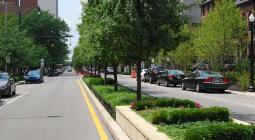The crowds flocking to Banksy’s latest work are missing the point: the damaged tree at its heart
City trees are an incredible green resource but are under serious assault. Banksy’s stark image shows the damage being done
Amid the excitement around Banksy’s latest art piece – a tree mural unveiled on a wall in Islington, north London – very little is being said about the tree at the centre of the story, a brutally pollarded 50-year-old cherry, and what it communicates about the way our urban trees are “managed”.
I visited it on Monday, just 10 minutes’ cycle from my house, and stood startled by the large, leafless tree, its bark darkened by pollution. It splays upwards like an agonised hand, with green paint – literal green wash – splashed up the wall behind it by a woman holding a pressure washer. But gradually I felt horrified, dismayed as the media filmed stories and crowds of people smiled, cooed and held their phones aloft for the latest Instagrammable image. People talked about whether the work could be “stolen” and the effect it would have on house prices and rents.
The human-centric chatter, of course, misses the point – why a mature urban tree is cut back so severely that it may never regenerate or spring into joyful blossom as it once did. Islington council claims the tree is “in decline” and shows signs of disease, but many urban trees have elements of fungal or other diseases and can live for years if well treated. And cherries do not respond well to rare and radical pruning. Even if it is sick, as the council says, sickness in trees can be sympathetically managed and worked with. Do we treat diseased humans with such brutality?
The local group Haringey Tree Protectors, of which I am a founder, works hard to raise the alarm, and the awareness of our council, about threats to our urban trees, but we are often vilified, ignored or dismissed. Last year, we ended up having a legal row over a tree we were trying to protect. I’m a big fan of Banksy’s work and in many ways grateful that he’s drawn attention to the hypocrisy and harm being done to our urban street trees, but why does it have to take an artist to make us sit up and notice the trees on our streets?
Mature street trees are a neglected, maligned lot. A whole industry has sprung up around chopping them down or pollarding them. In north London, where we are situated on dense clay soil, we are increasingly seeing trees pollarded in ever tighter cycles, so they never see leaf or provide canopy, giving a knuckle-like or Twiglet effect. Even worse, we are seeing more being topped, which is when the tree is cut almost to the crown – a bad practice.
We all know our tree canopy is an incredible green natural resource. Trees, a natural, free, green infrastructure system, work hard to give us oxygen to breathe, absorb our pollution, cool our streets down, reduce flooding and provide nesting habitats and food for birds and invertebrates. But that doesn’t mean big money cares. A perfect storm of commercial factors converge around trees: insurance companies blame trees for damage; developers attempt to clear their sites; there’s an inordinate number of mistakes by councils; and residents even sometimes complain that they block the light.
Risk factors for trees are set worryingly high: councils seem to be obsessed by the rare cases of falling branches and liability.
Trees are big news now, with fellings making headlines from Sheffield to Plymouth, and Wellingborough to Stroud Green, north London, where our own campaign to save a plane tree from insurers is ongoing. The Sycamore Gap tree, illegally felled in Northumberland, showed how much one nation can mourn its symbolic trees.
Planting trees has become a means for politicians to show they care and a misguided badge of eco-literacy by councils. But mature city trees are under assault as never before, and this is what I think Banksy’s work is showing. The artist chose his setting cleverly, and crowds will continue turning up to see the tree. But to me, his stark image communicates something much deeper – how we damage ourselves if we continue to allow or ignore the assault on urban nature. In the climate crisis we just can’t continue treating our tree canopy with such savagery.
Cover photo: ‘I felt horrified, listening in dismay as crowds of people smiled, cooed and held their phones aloft for the latest Instagrammable image.’ Photograph: Vuk Valcic/ZUMA Press Wire/REX/ Shutterstock



